The Western Digital WD Black SN850 Review: A Very Fast PCIe 4.0 SSD
by Billy Tallis on March 18, 2021 12:50 PM ESTMixed IO Performance
For details on our mixed IO tests, please see the overview of our 2021 Consumer SSD Benchmark Suite.
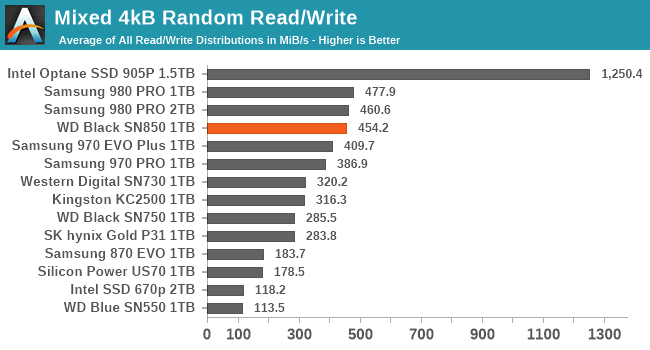 |
|||||||||
| Mixed Random IO | Throughput | Power | Efficiency | ||||||
| Mixed Sequential IO | Throughput | Power | Efficiency | ||||||
The WD Black SN850's overall performance on the mixed random IO test is just behind the Samsung 980 PRO, but still very good for a flash-based SSD. However, its power efficiency on that test is only second-tier, behind the 980 PRO and the SK hynix Gold P31.
On the mixed sequential IO test, the SN850's performance is better than any of the 1TB drives, and almost as fast as the 2TB 980 PRO. It's still not quite as efficient as the 980 PRO and during this test it averages about 6.6W, which is definitely getting up to where a heatsink would be of use (for similarly long-running workloads).
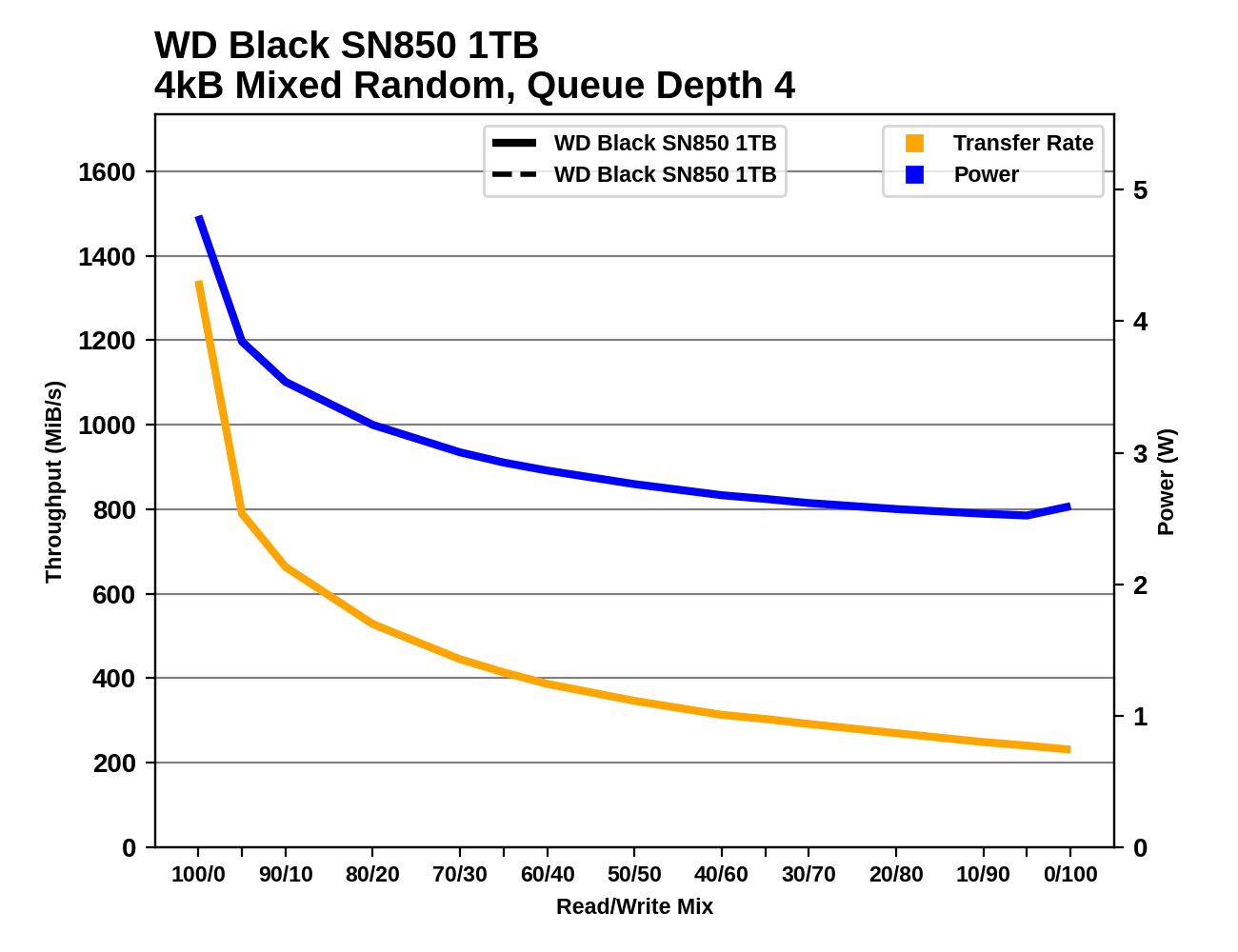 |
|||||||||
| Mixed Random IO | |||||||||
| Mixed Sequential IO | |||||||||
On the mixed random IO test, the SN850 starts out with a lead over the 980 PRO for the most read-oriented mixes but then the 980 PRO takes a small lead for the rest of the test while always using less power. On the mixed sequential IO test, it seems like the larger SLC cache may be helping the SN850 get a performance boost relatively early while there are still more reads than writes, and it maintains leading performance as the mix gets more write-heavy. That means the SN850 ends up having a considerable performance advantage over the 1TB 980 PRO for a 50/50 mix that would be expected from a workload like copying files within the same SSD.
Power Management Features
Real-world client storage workloads leave SSDs idle most of the time, so the active power measurements presented earlier in this review only account for a small part of what determines a drive's suitability for battery-powered use. Especially under light use, the power efficiency of a SSD is determined mostly be how well it can save power when idle.
For many NVMe SSDs, the closely related matter of thermal management can also be important. M.2 SSDs can concentrate a lot of power in a very small space. They may also be used in locations with high ambient temperatures and poor cooling, such as tucked under a GPU on a desktop motherboard, or in a poorly-ventilated notebook.
| WD Black SN850 1TB NVMe Power and Thermal Management Features |
|||
| Controller | WD/SanDisk NVMe G2 | ||
| Firmware | 611100WD | ||
| NVMe Version |
Feature | Status | |
| 1.0 | Number of operational (active) power states | 3 | |
| 1.1 | Number of non-operational (idle) power states | 2 | |
| Autonomous Power State Transition (APST) | Supported | ||
| 1.2 | Warning Temperature | 84 °C | |
| Critical Temperature | 88 °C | ||
| 1.3 | Host Controlled Thermal Management | Supported | |
| Non-Operational Power State Permissive Mode | Supported | ||
The WD Black SN850 implements the full range of power and thermal management features. It's specced for quick transitions in and out of its low-power sleep states. The drive indicates that it may use up to 9 W while active; it probably gets close at peak, but the highest sustained power draw we saw during our synthetic benchmarks was in the 7-8W range. Constraining this drive to either of its lower-power active states would definitely throttle performance by a lot.
| WD Black SN850 1TB NVMe Power States |
|||||
| Controller | WD/SanDisk NVMe G2 | ||||
| Firmware | 611100WD | ||||
| Power State |
Maximum Power |
Active/Idle | Entry Latency |
Exit Latency |
|
| PS 0 | 9.0 W | Active | - | - | |
| PS 1 | 4.1 W | Active | - | - | |
| PS 2 | 3.5 W | Active | - | - | |
| PS 3 | 25 mW | Idle | 5 ms | 10 ms | |
| PS 4 | 5 mW | Idle | 5 ms | 45 ms | |
Note that the above tables reflect only the information provided by the drive to the OS. The power and latency numbers are often very conservative estimates, but they are what the OS uses to determine which idle states to use and how long to wait before dropping to a deeper idle state.
Idle Power Measurement
SATA SSDs are tested with SATA link power management disabled to measure their active idle power draw, and with it enabled for the deeper idle power consumption score and the idle wake-up latency test. Our testbed, like any ordinary desktop system, cannot trigger the deepest DevSleep idle state.
Idle power management for NVMe SSDs is far more complicated than for SATA SSDs. NVMe SSDs can support several different idle power states, and through the Autonomous Power State Transition (APST) feature the operating system can set a drive's policy for when to drop down to a lower power state. There is typically a tradeoff in that lower-power states take longer to enter and wake up from, so the choice about what power states to use may differ for desktop and notebooks, and depending on which NVMe driver is in use. Additionally, there are multiple degrees of PCIe link power savings possible through Active State Power Management (APSM).
We report three idle power measurements. Active idle is representative of a typical desktop, where none of the advanced PCIe link or NVMe power saving features are enabled and the drive is immediately ready to process new commands. Our Desktop Idle number represents what can usually be expected from a desktop system that is configured to enable SATA link power management, PCIe ASPM and NVMe APST, but where the lowest PCIe L1.2 link power states are not available. The Laptop Idle number represents the maximum power savings possible with all the NVMe and PCIe power management features in use—usually the default for a battery-powered system but rarely achievable on a desktop even after changing BIOS and OS settings. Since we don't have a way to enable SATA DevSleep on any of our testbeds, SATA drives are omitted from the Laptop Idle charts.
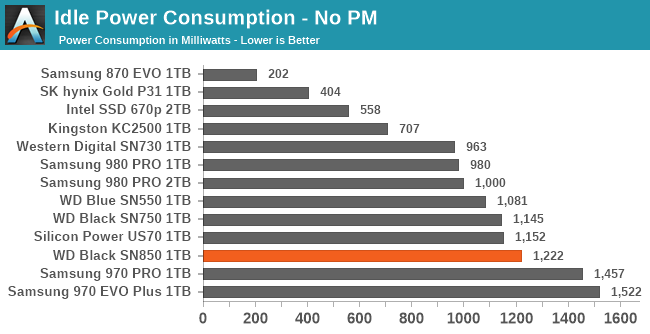
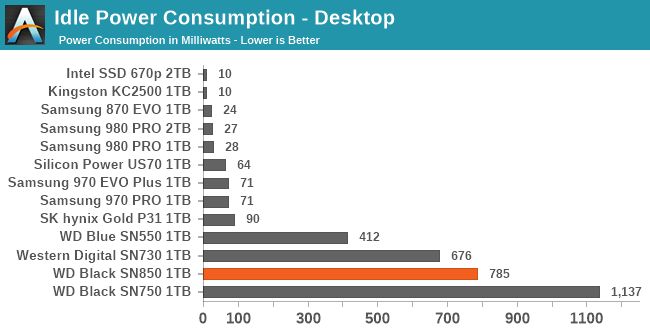
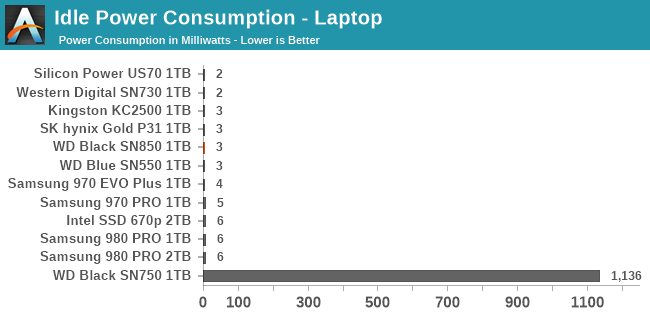
Typically for Western Digital's NVMe controllers, the active idle power consumption from the SN850 is high at over 1W, and the desktop idle state only drops that by 35%. But the SN850's deepest idle state gets power draw down to the appropriate range for use in a laptop. Wakeup from the desktop idle state is almost instant, but waking up from the deepest idle is quite a bit slower than on Samsung's drives. The SN850 still wakes up several milliseconds faster than indicated by its firmware, and it's not slow enough to be a serious concern for system responsiveness.
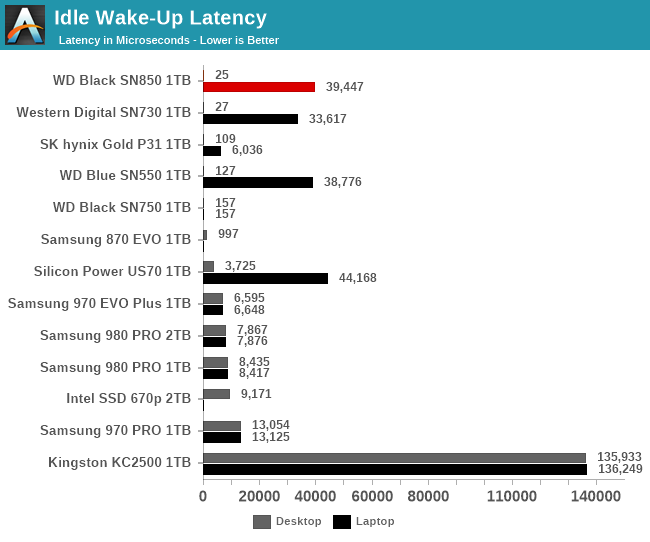










83 Comments
View All Comments
Chaitanya - Thursday, March 18, 2021 - link
Very interesting drive.bernstein - Thursday, March 18, 2021 - link
great review! thanks @anandtechabufrejoval - Thursday, March 18, 2021 - link
Somehow I think that I'll never be able to recover in the faster response times of this drive the time it would take me to swap it against the 980 Pro I currently have in my Ryzen 5800X workstation...Against any other with similar price and capacity, it would win. In absolute terms, I doubt it really matters for most, because the bottleneck will be somewhere else.
abufrejoval - Thursday, March 18, 2021 - link
actually an MLC 970 pro... need editXabanakFanatik - Thursday, March 18, 2021 - link
I was going to say.... Seems like this is a better performing drive than the 980 Pro. 970 pro, it's a close call. The upside is this ca be had in 2TBbji - Friday, March 19, 2021 - link
If you swap it at a time when you otherwise would not be using the computer, then you effectively don't have to "recover" anything.Spunjji - Friday, March 19, 2021 - link
No, but that's an odd way to look at it. There's no need to replace a perfectly good drive!Linustechtips12#6900xt - Thursday, March 18, 2021 - link
I think that this is. a decent drive after skimming threw the article but i definitely do wonder how far the M.2 standard will be in use obviously a while im not saying its obsolete but when U.3 exists. I think that 2.5in drives will make a come back because in all honesty you cant fit everything on a 2tb drive and capacity that high is EXPENSIVE so i think 2.5in U.3 is gonna be where its at and im gonna wait for it to, i wanna get something better than a hdd for my game storage but when sata is going out i dont wanna buy a sata ssd.eva02langley - Thursday, March 18, 2021 - link
The playstation 5 use NVMe, so it is going to be around for a while. SATA is definitely dead.futrtrubl - Thursday, March 18, 2021 - link
Don't confuse NVMe and M.2.